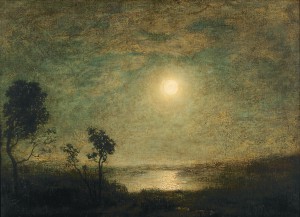Ralph Blakelock
Description of the Tonalist Painting Style and Technique
Ralph Blakelock
American Tonalism is rooted in the French Barbizon movement, which emphasized atmosphere and shadow. The Tonalist style employs a distinctive technique by the use of color’s middle values as opposed to stronger contrast and high chroma. Resulting in a understated and compelling overall effect. The tonalist subject matter is never entirely apparent; their is no effort to communicate a message or narrate a story. Instead of relating a story, each sensitively chosen color, composition, and line is arranged to create an intriguing visual poem.
The interiors of tonalist paintings are generally elegant and sparsely decorated, tonally uniform, simplified and indistinct; the figures are usually presented alone in silent contemplation. Landscapes are typically luscious and luminous with evocative atmospheric effects featuring misty backgrounds illuminated by moonlight. Tonalists painters were drawn to both the natural and spiritual realms. They sought to awaken the viewers consciousness by shrouding the subject in a misty indistinct veil of emotionalism. The palette is minimal, characterized by warm hues of brown, soft greens, gauzy yellows and muted grays. Preferred themes were evocative moonlight nights and poetic, vaporous landscapes. Tonalist painters seemed to favored unconscious states and psychological experiences over reality.
-Taken from historyofpainters.com


Comments are closed.